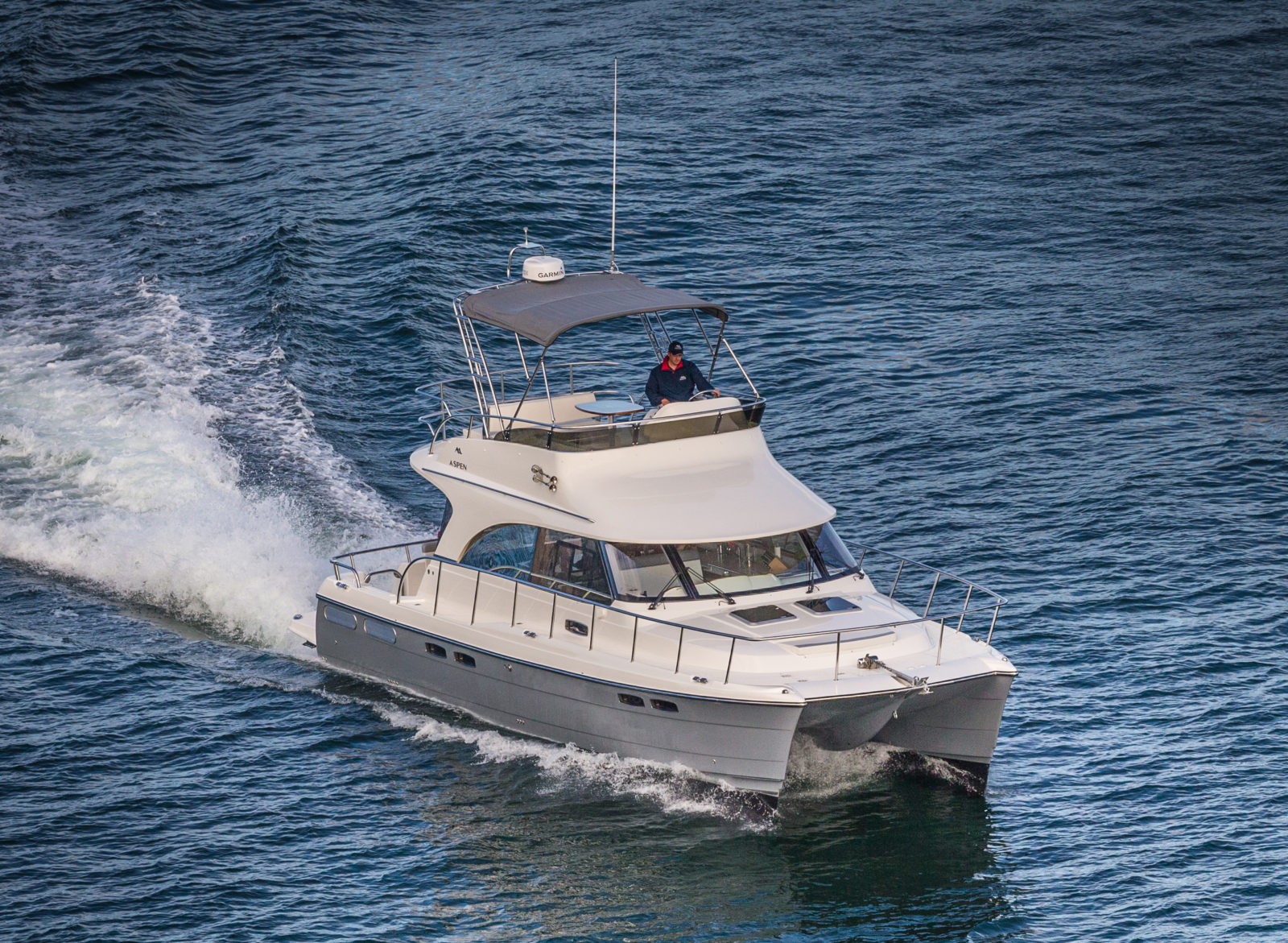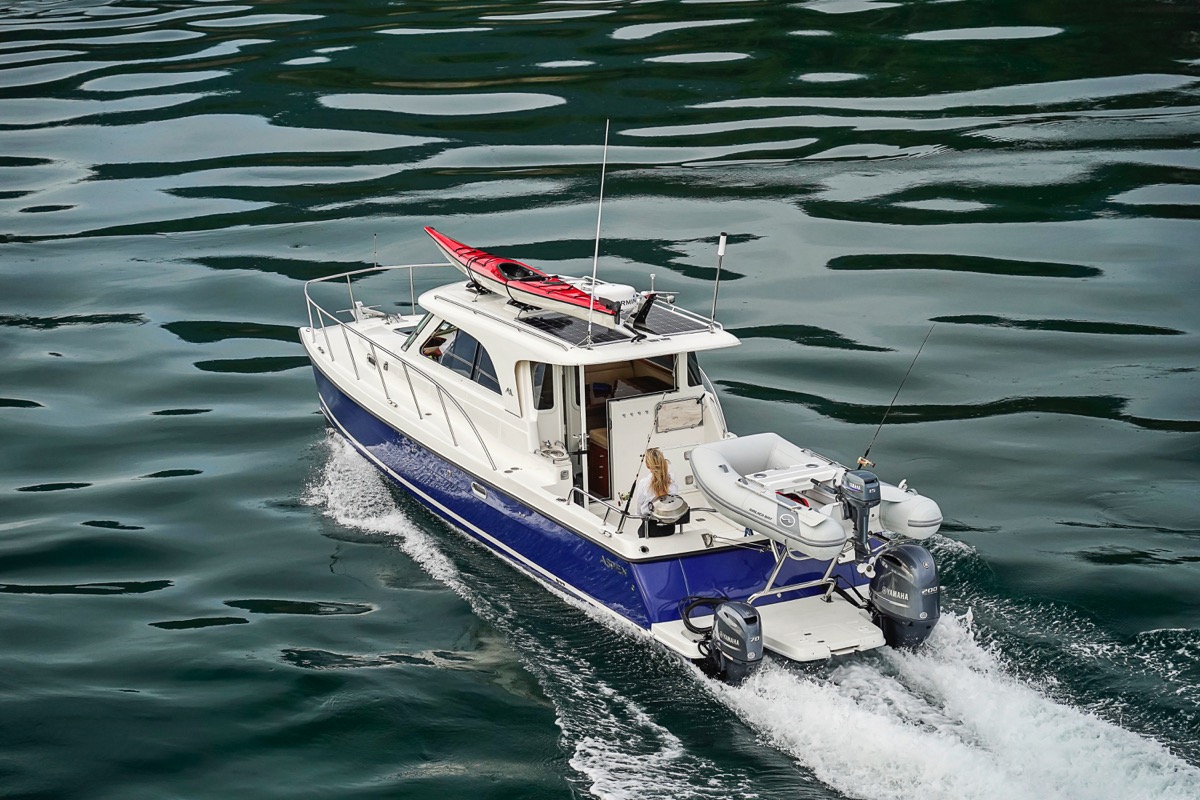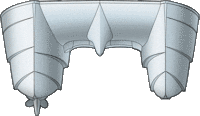Engine Innovation
Aspens Make the Most of Engines, No Matter What Configuration
Aspens run on a single diesel engine or two mismatched outboards, depending on the model chosen. Both configurations have their advantages, depending on the boating experience you’re after.
Single-Diesel Power Drives
The single diesel power proa hull carries many advantages in her design. While identical in profile, the two hulls are very different in plan view, with one hull 35 percent thinner than the other. Additionally, the design utilizes only one engine, shaft, prop, and keel. The design’s asymmetrical hulls are shaped to compensate for the engine torque. Since both forces are proportional to speed and thrust, the boat runs straight. We call this the SeaGlider system.
The benefits of the SeaGlider technology are significant. While the thinner proa hull is only 35 percent thinner, its actual drag is approximately 50 percent less. This fluid-dynamic relationship is best summed up as “a little thinner equals a lot less energy.” This hull also has none of the typical, twin-engine appendage drag seen on most boats. Drive gear such as the keel, shaft, rudder, and prop typically add another 20-percent drag.
Beyond this, the single engine design saves dramatically on machinery weight, which in turn saves on the required structure component sizes, plus additional necessary fuel and the corresponding weight of that load. All these savings reduce the boat’s weight by approximately 40 percent. The result of less weight is much less drag.
Aspen offers boaters a perfect haven due to its balance of environmental and performance efficiencies in combination with its roomy layout and exceptional comfort. The aspen hull and its many benefits are all rooted in solid engineering principles and creative innovation.

Case Study: The Aspen C120 Runs Straight with Two Hulls and One Engine
The C120 uses Aspen’s patented award-winning hull design for ideal performance with a state-of-the-art Volvo Penta D6 diesel. Design cruise speeds are 16 to 18 knots with a top speed of 20 to 23 knots, depending on the horsepower (370 horsepower or 435 horsepower). Fuel economy with the single 435-horsepower diesel is 10 gph at 16 knots; that’s 50 to 60 percent lower fuel burn than competitive boats. Your fun cruising range just doubled in a day!
Outboard Power Like No Other Boat
At Aspen we understand that many boaters today are looking for outboard power, and we’ve received a lot of input from our owners and prospective buyers. Over the years buyers have said they like what we do in terms of efficiency, stability, cabin space, and style, but wanted the versatility outboards provide. Some needed to cut across sandbars and draft was an issue. Others travel to areas where it is easier to service outboards, or head far offshore and prefer the redundancy and peace of mind twin engines provide. Some buyers just prefer outboards: Having grown up with them, they understand them better.
Aspen’s Founder and President Larry Graf noticed his earlier-designed twin-outboard catamarans could successfully run off a single engine with slight steering corrections. And he has always understood the efficiency, speed, and performance outboards can achieve. With the technological developments that outboards have undergone in the last decade, they are cleaner, quieter, and more fuel efficient than ever. Larry set out to integrate outboard power into his patented proa design to provide added benefits and efficiency.
Larry saw an opportunity to incorporate outboard power to create even more of an advantage for Aspen owners. He tested our asymmetrical hulls with a single engine like on our inboard boats and they ran well. Since many outboard fishermen would also want to troll, he then experimented with adding a smaller trolling motor to the other hull. At first he thought that the trolling motor would be tilted up when running at speed but he soon found that the smaller outboard added appendage drag that helped with tracking, largely because the outboard-powered hulls lacked the keel of the inboard boats. He soon realized that if you are going to have both engines in the water you might as well power them both while running. Dialing in the size and power of the engines as well as the hull shape he came up with the optimal running setup and the first asymmetrical outboard-powered catamaran was born.
As with any new model or change, we do extensive testing and sea-trialing. The results of this power package were surprisingly good. The outboard model topped out at speeds that were 20 percent faster than the diesel inboard version of the same boat. We categorize the acceleration as startling, and we’ll leave it at that. These outboards are a lot different than those that many of us used to know: They’re actually quieter at cruising speed than the inboard diesel. With power tilt, we can reduce the draft of the boat to 22 inches. On one engine she’ll run at 8 knots, and single-engine operation also can reduce trolling speed to less than 1.8 knots.
While our outboard-powered boats have some advantages over the diesel-powered boats, there are some differences to consider. For example, a boat powered by the two outboards will burn 15 percent more fuel than the single-diesel model. Outboards will not last as long as a robust diesel engine, but repowering is easier. Storing a dinghy is a little trickier with outboards, but we have designed a patent-pending davit system that is fast and easy to use.
Outboard power is very popular today and many owners are willing to sacrifice some fuel efficiency and engine longevity for faster top-end speeds and other advantages. Aspen delivers top efficiency in their outboard models compared to other outboard-driven boats in their size and class and continues to offer a full line of diesel inboards too.

Case Study: The Aspen C107 Runs Straight with Two Outboards of Different Horsepower
Our Aspen C107 is optimally paired with 200- and 70-horsepower outboards. Together they provide a nice balance for our Power Proa hull. The engines run perfectly in unison or individually. They both are rated for the same maximum rpm range of 5,000 to 6,000, have the same lower-unit gear ratio, and use similarly pitched props. The motors deliver thrust proportional to their horsepower at the same rpm. Since the port hull is 35 percent narrower, it takes about 50 percent less energy to slip through the water. We changed the starboard hull so it no longer has the keel form and prop pocket. The hull shape at the bow still lets the boat run in balance: No helm correction is needed, and hands-free tracking is on par with our inboard design.
